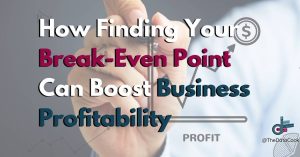
Why Most Profit Calculations Are Wrong: Debunking Common Myths
In the realm of business, profit calculations play a pivotal role in assessing financial success. However, many entrepreneurs and professionals rely on a flawed method that fails to capture the true profitability of their ventures. The widely accepted belief that profit equals the sale price minus the cost of an item oversimplifies the complex nature of profit calculations.
In this article, we will delve into the myths associated with this conventional approach and shed light on the factors that are often neglected. By understanding why most profit calculations are wrong, you can make informed decisions to drive sustainable financial growth.
Overview: In this comprehensive guide, we will explore the common myths surrounding profit calculations, including:
- Ignoring overhead expenses.
- Neglecting production and manufacturing costs.
- Excluding storage and transportation costs.
- Disregarding returns and refunds.
- Neglecting seasonal and market fluctuations.
- Ignoring discounts and promotions.
- Neglecting research and development costs.
- Neglecting marketing and advertising costs.
- Disregarding obsolescence and depreciation
- Assuming a simplistic cost structure.
By debunking these myths, you will gain a deeper understanding of accurate profit calculations and empower your business for financial success. Let’s dive in!
Myth 1 - Ignoring Overhead Expenses
Many profit calculations overlook the significance of overhead expenses, leading to inaccurate assessments of true profitability. Overhead expenses include costs such as rent, utilities, salaries, and marketing expenses. Failure to consider these expenses results in an incomplete understanding of the financial health of a business.
Myth 2 - Neglecting Production and Manufacturing Costs
The conventional formula often fails to incorporate the expenses related to producing or manufacturing an item. Costs such as raw materials, labor, machinery, and quality control are essential components of accurate profit calculations. Neglecting these costs distorts the true picture of profitability.

Myth 3 - Excluding Storage and Transportation Costs
The conventional formula often fails to incorporate the expenses related to producing or manufacturing an item. Costs such as raw materials, labor, machinery, and quality control are essential components of accurate profit calculations. Neglecting these costs distorts the true picture of profitability.
Myth 4 - Disregarding Returns and Refunds
The assumption that all sales are final disregards the potential for returns, refunds, and associated costs. Ignoring these factors leads to an overestimation of profits and fails to account for the impact of customer dissatisfaction, product defects, or changes in demand
Myth 5 - Neglecting Seasonal and Market Fluctuations
Profitability can vary based on seasonal demand and market trends. Neglecting to consider these fluctuations leads to inaccurate profit calculations that do not reflect the true financial performance of a business. Understanding and incorporating these fluctuations is crucial for accurate profit assessments.

Myth 6 - Ignoring Discounts and Promotions
Offering discounts and running promotional campaigns are common practices in business. However, the traditional profit calculation method does not account for the impact of these discounts on the final profit earned per item sold. Neglecting to consider these factors results in an incomplete view of profitability.
Myth 7 - Neglecting Research and Development Costs
Businesses engaged in innovation or product development incur costs related to research, design, prototyping, and testing. Neglecting these expenses in profit calculations fails to account for the investment made in developing new products or improving existing ones, leading to inaccurate assessments of profitability.
Myth 8 - Neglecting Marketing and Advertising Costs
Businesses engaged in innovation or product development incur costs related to research, design, prototyping, and testing. Neglecting these expenses in profit calculations fails to account for the investment made in developing new products or improving existing ones, leading to inaccurate assessments of profitability.
Myth 9 - Disregarding Obsolescence and Depreciation

Some items may lose value over time due to technological advancements, changing trends, or wear and tear. Failure to consider these factors in profit calculations skews the true profitability assessment and hinders informed decision-making.
Myth 10 - Assuming a Simplistic Cost Structure
The traditional formula assumes a straightforward cost structure, disregarding the complexity of various cost components. Businesses often have diverse cost elements that need to be accounted for to calculate accurate profits. Ignoring this complexity leads to distorted profit calculations.
Now that we have debunked these myths, let’s explore how you can identify wrong profit calculations and implement accurate methods to drive financial success.
How to Identify Wrong Profit Calculations
To ensure accurate profit calculations, follow these steps:

- Evaluate all direct and indirect costs associated with your products or services, including overhead expenses, production costs, and marketing expenditures.
Step 2:Track All Relevant Expenses:
- Keep meticulous records of expenses incurred throughout the lifecycle of your products or services, including research and development, marketing campaigns, and operational costs.
Step 3 Consider Market and Seasonal Fluctuations:
- Analyze historical data and market trends to identify patterns of demand and adjust your profit calculations accordingly.
Step 4: Factor in Returns, Refunds, and Discounts:
- Estimate the potential impact of returns, refunds, and discounts on your overall profitability to get a more accurate assessment.
Step 5: Use Advanced Profit Calculation Methods:
- Explore alternative profit calculation models, such as contribution margin analysis, activity-based costing, or gross margin calculations, to gain deeper insights into your business’s financial performance.
Profit Calculation Tips
Here are some additional tips to improve your profit calculations:

Regularly Review and Update Your Cost Estimates:
- Revisit your cost estimates periodically to ensure they remain accurate and reflect any changes in your business operations or the market.
Implement Robust Accounting Systems:
- Utilize accounting software or systems that enable you to track expenses and revenue streams efficiently, providing a solid foundation for accurate profit calculations.
Seek Professional Advice:
- Consider consulting with financial experts or accountants who can help you develop more precise profit calculation methods tailored to your specific business needs.
Profit Calculation Tools
To support your profit calculations, consider utilizing the following tools:

- Accounting Software: Platforms like QuickBooks, Xero, or FreshBooks can simplify the process of tracking expenses and generating financial reports, enhancing your profit calculation accuracy.
- Pricing and Profitability Tools: Tools such as ProfitWell, Price Intelligently, or Zoho Books offer features that assist in pricing optimization and profit analysis, enabling you to make informed decisions.
- Financial Analytics Platforms: Solutions like Tableau, Google Analytics, or Power BI can provide comprehensive insights into your business’s financial performance, facilitating accurate profit calculations.
Conclusion
Embrace accurate profit calculations, explore alternative methods, and leverage the available tools to unlock the true potential of your business. By implementing accurate profit calculations, you can steer your business towards sustainable growth and financial prosperity.
Express Recipe to Recipe for Goal Setting Using Data:
Calculating profits can be tricky. The ‘traditional’ way takes the sale of the product and reduces by cost of items used to make a product.
Sale: $10 – Cost of items $6 = Profit $4
However, there are a lot of other items that are needed to make the sale happen.
Some of these do get added into calculations such as payment providers, and tax(es).
There are some additional expenses that can get overlooked in the calculation at a product or service level and turn up later in the profit and loss (sometimes unexpectedly).
By finding these expenses and breaking them down to a modest calculation you can get a better understanding of where your profits are going.
Some of these expenses could be labour – estimate the time invested into the product/service and allocate a cost.




